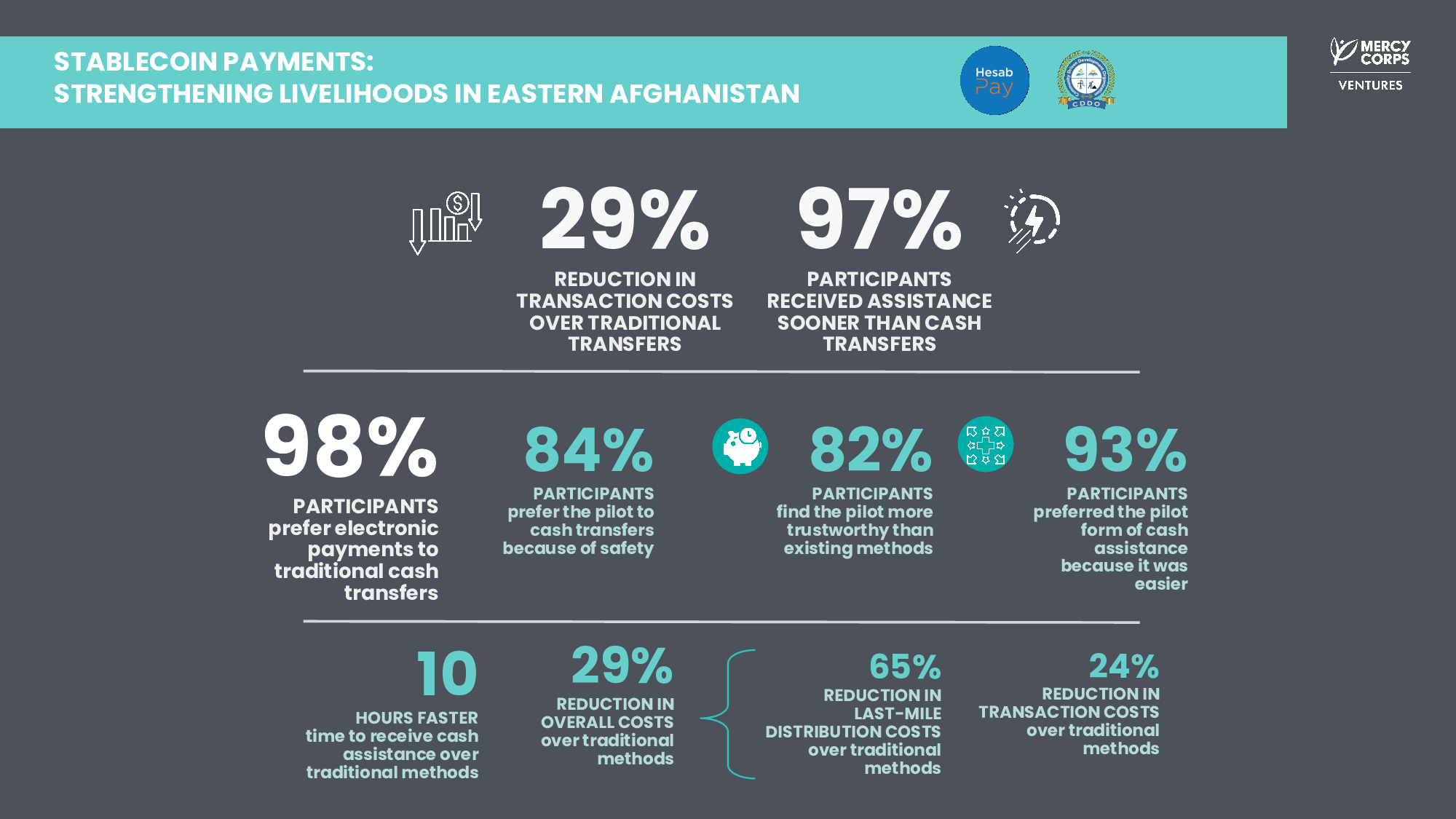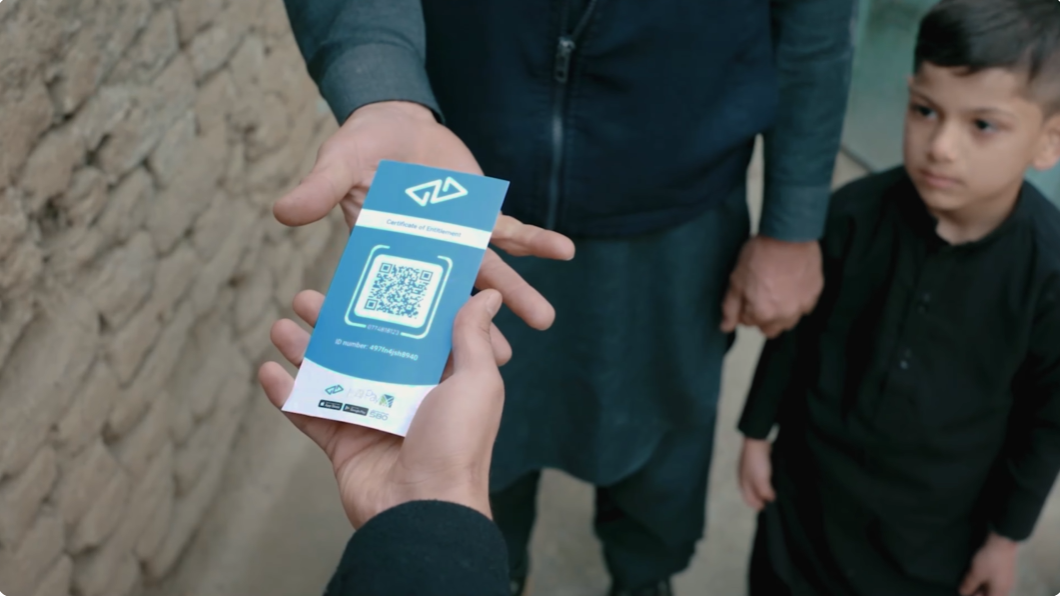Pilot Insights | Stablecoin Payments Cut Costs, Increase Safety in Afghanistan
Photo courtesy of HesabPay
Insights in Brief
Cost improvements: 29% reduction in total delivery costs compared to traditional cash transfers; 65% reduction in operational distribution costs, and transaction costs reduced from 5.9% to 4.2%;
Speed benefits: Aid was delivered 10 hours faster than the status quo model of delivering cash in hand;
User preference: 98% of participants preferred electronic payments to traditional cash transfers, citing safety (84%), trustworthiness (82%), and ease of use (93%)
Overview
Since the Taliban's return to power in 2021, Afghanistan's formal banking system has stalled under sanctions, forcing humanitarian organizations to rely on expensive informal money transfer agents (IMTAs) charging up to 10% in fees and cash shipments through insecure areas—even as 23 million Afghans require assistance.
In early 2025, Mercy Corps Ventures partnered with HesabPay, a blockchain-based digital payment platform, and Community Driven Development Organization (CDDO), a local Afghan NGO with three decades of development experience, to launch a three-month pilot testing stablecoin-based aid delivery in eastern Afghanistan.
For this pilot, the solution addressed a unique challenge: how to deliver digital payments to communities with zero internet connectivity. The team deployed:
Stablecoin payment rails that eliminated reliance on informal money transfer networks and reduced international transfer costs
Physical cards linked to digital wallets that could be used completely offline by beneficiaries
Merchant acceptance points equipped with satellite internet to sync transactions
HesabPay branch offices where merchants could convert digital funds to local currency
The mechanics worked as follows:
Mercy Corps Ventures sent funds via stablecoin (USDC) directly to CDDO's HesabPay digital wallet. CDDO then distributed 30,000 HAFN (a stablecoin pegged to the Afghan Afghani) to 100 families across several rural localities in the Zurmat district of Paktia province. Each family received a physical HesabPay card linked to a digital wallet. Participants used these cards at four participating local merchants selling food, medication, and agricultural supplies—three located in Badruddin Bazaar regional marketplace. Merchants accepted card payments offline, then travelled to HesabPay's branch office in neighbouring Ghazni city to exchange their digital funds for physical currency.
A total of 100 families and 4 merchants participated, reaching 872 people in communities that previously had no access to digital payments or reliable banking services.
Results
Faster aid delivery: The pilot reduced delivery time by an average of 10 hours compared to traditional cash distributions, with 97% of participants receiving assistance sooner than conventional methods—eliminating dangerous travel to cash distribution sites in insecure areas.
Significant cost savings: Overall costs decreased by 29% compared to previous cash programs. The savings come primarily from distribution costs that dropped by 65% thanks to direct digital disbursements that eliminated security expenses ($4.80 per person savings or 29% of distribution costs). Transaction costs were reduced from 5.9% to 4.2%.
Overwhelming preference despite no prior digital experience: Despite participants having zero internet access, smartphones, or digital payment experience, 98% preferred electronic payments over cash, citing safety (84%), trustworthiness (82%), and ease of use (93%), with 100% successfully using their offline-capable cards.
Enhanced safety and reduced fraud risks: Digital disbursements eliminated physical cash handling vulnerabilities—critical in a context where 38% of participants had previously experienced fraud in cash distributions—while providing complete transaction traceability for donor compliance.
Learnings
The learnings from this pilot were multi-fold: technological, social, economic, and regulatory factors all influenced implementation and outcomes in ways that offer important insights for future digital aid delivery.
Technical Innovation Meets Offline Reality
The pilot's most significant technical achievement was proving that stablecoin-based aid delivery can work in offline, remote environments. Participants with no smartphones, no internet access, and no prior digital payments experience successfully used physical cards linked to blockchain-based digital wallets. As CDDO staff member Soubhanullah Saleh explained,
“Lots of beneficiaries will not be satisfied with traditional cash because on the specific day, they are obliged to visit the site to receive their entitlements, even if they were in a faraway location.”
This solution eliminated this challenge entirely.
However, minimum connectivity is still required and might prove challenging. After the pilot concluded, authorities instituted a nationwide internet shutdown in September 2025. While HesabPay's use of satellite internet for merchant connectivity provided some resilience, the team is evaluating options for maintaining operations.
Social and Gender Barriers
Despite 58% of initial registrants being women (completed on their behalf by male family members), women were unable to use the cards due to the De Facto Authority's policies. Rather, male relatives used the cards on behalf of the female family members. Women in the pilot region are not permitted in public without male family members, creating a fundamental barrier to financial service access. By pilot's end, only 42% of survey respondents were the original registered participants—the remaining 58% were the male relatives (husbands, sons, or brothers).
This outcome underscores that technology alone cannot overcome systemic social and policy barriers. Future implementations must consider how to design for contexts where women may inform spending decisions but cannot independently access services.
Limited Merchant Networks in Rural Areas
The pilot engaged four merchants, and 92% of participants requested more facilities to increase their opportunities to use the platform. The limited merchant network meant participants had fewer places to spend their digital funds compared to cash. Positively, all four merchants reported improvements on their businesses and user satisfaction, noting that:
“[It] had a very positive impact on our work and workload. [Our business] improved because people were comfortable doing business with us”, and “found it easy to buy goods and grasp the value of electronic money. It’s a good way to save money”
Operational Advantages for Local NGOs
From an implementation perspective, the pilot demonstrated clear advantages for local NGO operations.
“There’s a lot of problems with cash. We tend to lose a lot of money that way [due to graft, security issues],”
Beyond security, the one-time account creation process proved significantly easier than repeated cash distributions requiring careful security planning. As Sandra Uwantege Hart from Mercy Corps Ventures observed:
“Local NGOs like CDDO bear the brunt of moving humanitarian cash into Afghanistan—with far fewer resources. HesabPay changes that with direct, traceable cash and automated distribution.”
Photo courtesy of HesabPay
Next Steps
Despite the challenges encountered, this pilot yielded several critical insights for humanitarian organizations and digital payment providers working in fragile, sanctioned, or connectivity-limited environments. While stablecoin technology continues to hold great promise for addressing aid delivery challenges, gaps remain—particularly around merchant network development, sustainable operations during connectivity disruptions, and ensuring inclusive access regardless of gender.
The HesabPay team is currently evaluating operational options in response to Afghanistan's internet restrictions, leveraging satellite connectivity and exploring how their decentralized infrastructure might provide advantages over centralized financial systems in volatile policy environments. Simultaneously, HesabPay has completed a successful pilot in Northeastern Syria, and Mercy Corps Syria country office is exploring longer-term integration of stablecoins into their programming. This expansion provides an opportunity to compare implementation across different governance contexts and in newly unsanctioned environments where formal banking actors may be re-entering.
For builders and organizations working in this space, key takeaways include: the demonstrated viability of offline-capable digital payments even in the most challenging environments; the importance of local NGO partnerships for rapid, trusted deployment; the continuing need to design around social and policy barriers that technology alone cannot solve; and the significant potential for cost savings and efficiency gains that can ultimately increase impact for vulnerable communities.
This article is the second of a two-part series. The first blog outlined the pilot launch, our learning questions, and the hypotheses we set out to prove. The final report provides an in-depth study of the market need, the impact of the solution, and the key insights and learnings from the pilot. If you’re short on time, read the TL;DR case study.
The evaluation was conducted by independent research partners at Crypto Council for Innovation.
Written by Maciej Bulanda – Humanitarian Venture Lab, Mercy Corps Ventures





